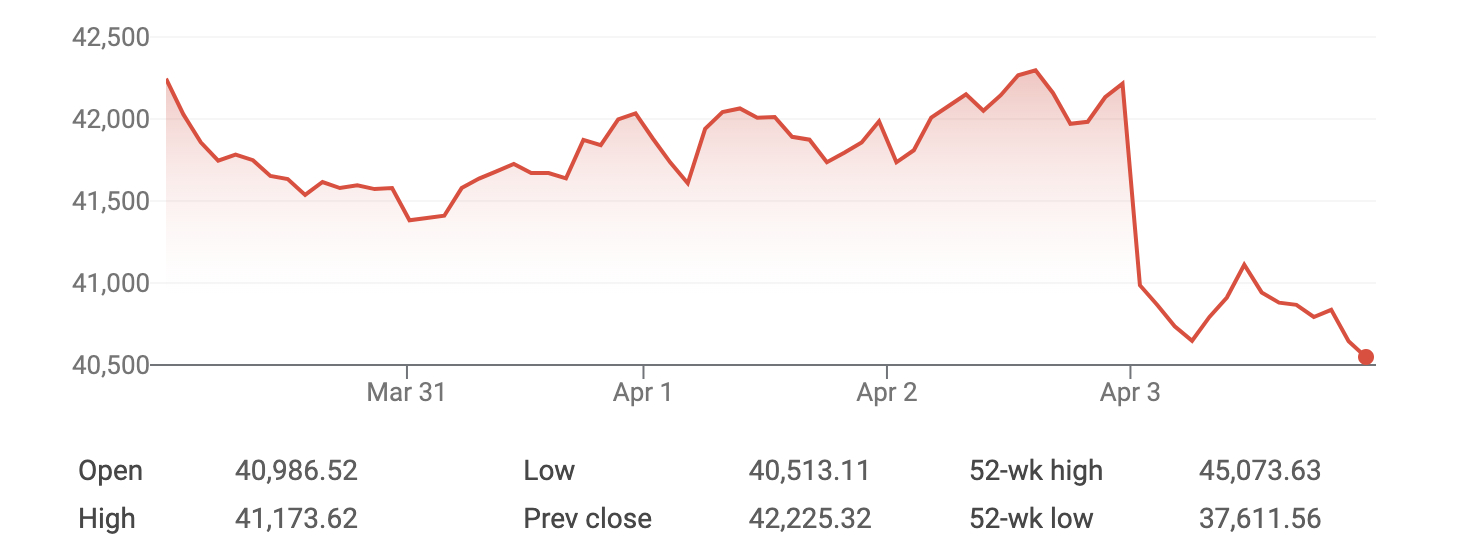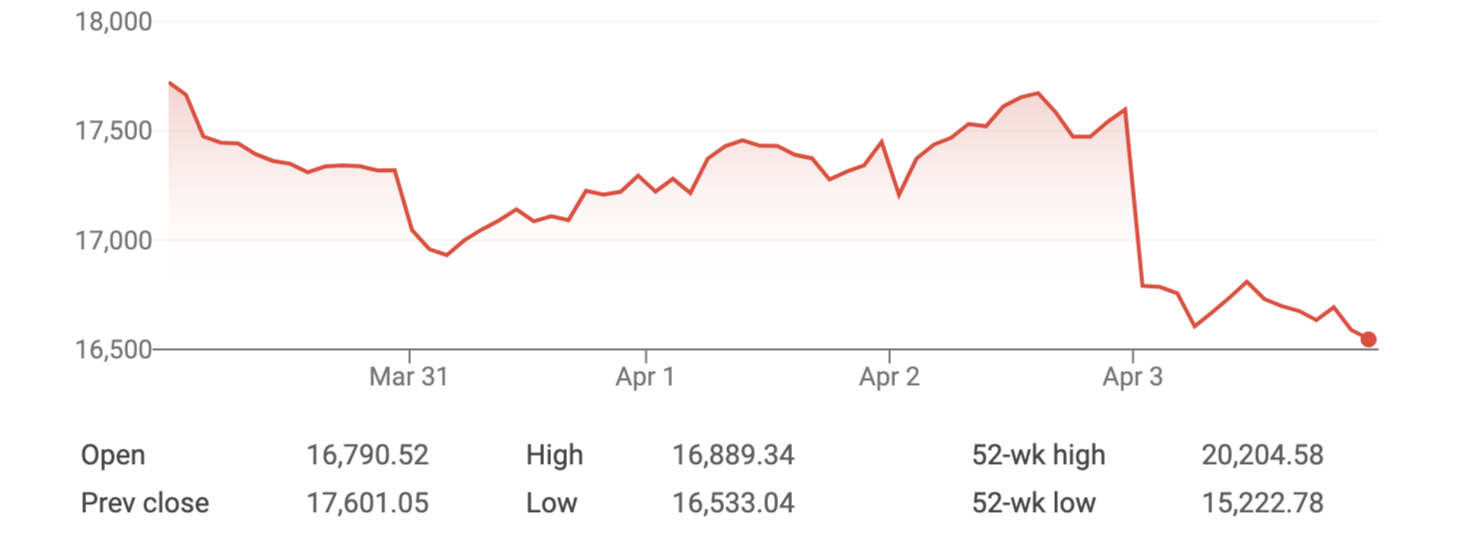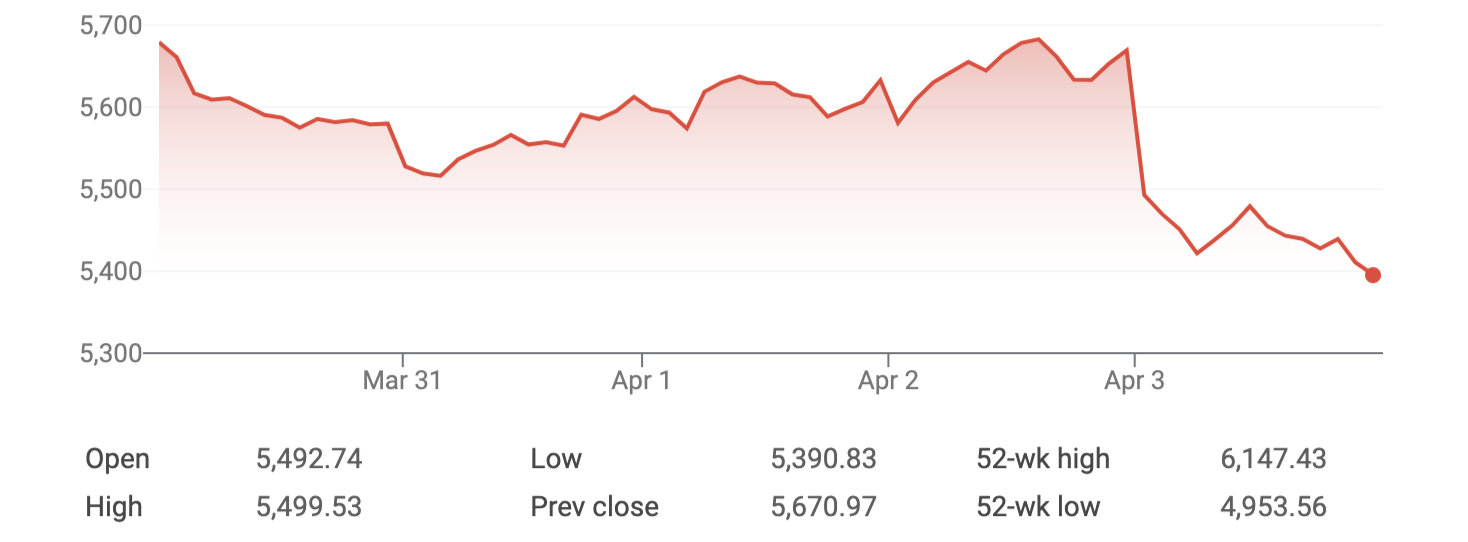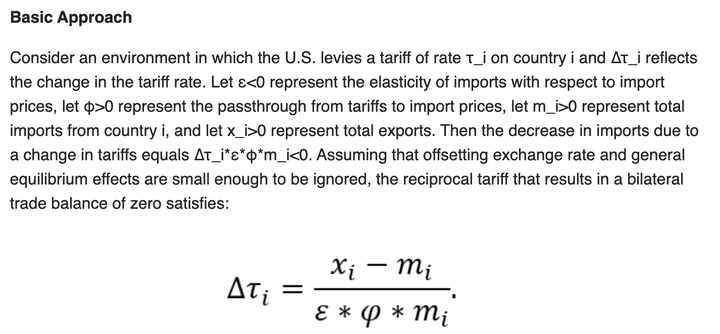The Trade War: Trump's Tariff Plan Is Top Secret!
We are now a couple of days into Donald Trump's latest trade war, and it is absolutely dominating the
news. We pored through a vast number of stories, and picked out the 10 storylines we think are most worth
noting:
- The Market Responds: Let's start our section on how the markets reacted to the
trade war with some art. Here's the last 5 days for the Dow Jones:

And here's the last 5 days for the NASDAQ:

And here's the last 5 days for the S&P 500:

Those pretty much tell the tale, although if you would like the raw numbers, the Dow Jones fell 1,679 points (4%) yesterday,
the NASDAQ fell 1,050 points (6%), and the S&P fell 274 points (4.8%). This is the worst day the stock market has had
since the early days
of the COVID-19 pandemic, back in 2020. Incidentally, Trump was president then, too.
As of 3:30 a.m. PT, Dow Jones futures suggest the market will have another bad day today. Not as bad as yesterday, mind you,
more of a mini-bloodbath.
- Canada Responds: We are surprised that more nations did not announce countermeasures yesterday,
since everyone knew this was coming. But Canada, at least, was (partly) ready, with PM Mark Carney
announcing
25% tariffs on American-made automobiles. We presume that other nations will be making announcements soon;
maybe the delay was so they could see exactly how harsh the Trump tariffs were, or maybe they are cooling their
jets for a few days to see if Trump backs down (again).
(Indeed, moments before we went live, China
announced
a 34% tariff on U.S. goods.)
- The Spin: The spin operation operated by the White House, and its friends in the media,
was in full effect yesterday. Trump himself took exactly one question from reporters yesterday, and it was about how
the tariffs are going. He
responded:
I think it's going very well. It was an operation, like when a when a patient gets operated on. It's
a big thing. I said this would exactly be the way it is. We have six or seven trillion dollars
coming into our country... the markets are going to boom.
We must agree on one point; we often find that things are exactly the way they are.
White House Press Secretary Karoline Leavitt was living in a dimension perhaps even further removed from reality than
the one Trump is, and declared there "is not going to be any pain" for American workers due to the tariffs.
And former White House spokesperson, and ongoing Trump sycophant, Kellyanne Conway celebrated the "positive" reaction
to the tariffs coming from Stellantis (whose brands include Chrysler, Dodge, Jeep, and Ram Trucks). That positive
reaction was... the company
laid off 900 workers.
That word that you keep saying, Kellyanne. I do not think it means what you think it means.
Over at Fox, The Five co-host Jeanine Pirro celebrated the tariffs, and said "I don't really
care about my 401(k)." Perhaps, and we're just spitballing here, when you have an annual salary of
$3 million, like Pirro does, you don't need to worry so much about your IRAs. Fox News anchor John
Roberts
predicted
that the stock market would skyrocket, and the Dow Jones would be above 50,000 by the end of the year.
The folks at Newsmax actually
rang the bell
to commence trading on Wall Street yesterday, and CEO Christopher Ruddy projected an "exciting day."
We suppose he was right, but probably not in the way he meant. Among the stocks hardest-hit during
the exciting day yesterday was... Newsmax, which went public on Monday. The price was artificially
high because it became a meme stock, but not so much anymore. The value of the stock dropped by 77%
yesterday, wiping out $24 billion in value.
- Blowback: The much louder voices yesterday were the ones criticizing the
tariffs. We won't bother with any Democratic politicians, since you know they aren't going to say nice
things. Instead, let's talk finance experts, and maybe a Republican or two.
To start, the regular staff of Fox is in the bag for Trump, but some of their contributors did not get
the message, at least not on tariffs. Ben Domenech, for example,
said:
"Look, I hate tariffs, I think they're stupid. I think they're backwards. I don't think they help the American economy."
Over at CNBC, Jon Fortt
added:
"And the market reaction after hours, I've never seen anything like it.
This, I think, fair to say, is worse than the worst-case scenario of the tariffs that many in the market expected the president to impose."
Meanwhile, Jim Cramer, who might be the most famous stock market analyst in the country,
lamented:
[T]hey screwed it up and they really made—they did it a totally ill-advised way. And I was very let
down as someone who really, truly believes that free trade is awful for the American working person.
This is what they came up with? Jeez, come on! Have some gumption. Have some math.
He also added: "I feel like a sucker tonight."
Meanwhile, The Economist published an absolutely blazing
editorial
(subscription required) which included this assessment:
Almost everything Mr. Trump said this week—on history, economics and the technicalities of
trade—was utterly deluded. His reading of history is upside down. He has long glorified the
high-tariff, low-income-tax era of the late-19th century. In fact, the best scholarship shows that
tariffs impeded the economy back then. He has now added the bizarre claim that lifting tariffs
caused the Depression of the 1930s and that the Smoot-Hawley tariffs were too late to rescue the
situation. The reality is that tariffs made the Depression much worse, just as they will harm all
economies today. It was the painstaking rounds of trade talks in the subsequent 80 years that
lowered tariffs and helped increase prosperity.
On economics Mr. Trump's assertions are flat-out nonsense. The president says tariffs are needed to
close America's trade deficit, which he sees as a transfer of wealth to foreigners. Yet as any of
the president's economists could have told him, this overall deficit arises because Americans choose
to save less than their country invests—and, crucially, this long-running reality has not
stopped its economy from outpacing the rest of the G7 for over three decades. There is no reason why
his extra tariffs should eliminate the deficit. Insisting on balanced trade with every trading
partner individually is bonkers—like suggesting that Texas would be richer if it insisted on
balanced trade with each of the other 49 states, or asking a company to ensure that each of its
suppliers is also a customer.
Pulling absolutely no punches, the magazine denounced Trump's trade war as "the most profound,
harmful and unnecessary economic error in the modern era." Ouch.
Moving on to the politicians, Mike Pence got on eX-Twitter
to share his view that
"The Trump Tariff Tax is the largest peacetime tax hike in U.S. history. These Tariffs are nearly
10x the size of those imposed during the Trump-Pence Administration and will cost American families
over $3,500 per year." And while Pence is persona non grata in the White House these days, the trade
war was also blasted by someone who is generally more than happy to tote the administration's water,
namely Sen. Ted Cruz (R-TX). He
said:
"Tariffs are a tax on consumers and I'm not a fan of jacking up taxes on American consumers."
- In Congress: In addition to Cruz, quite a few Republican members of
the Senate expressed unhappiness with the tariffs yesterday, among them Thom Tillis (NC), John
Kennedy (LA), Ron Johnson (WI), Susan Collins (ME) and, perhaps most notably, Chuck Grassley (IA).
Several members in both chambers are putting together legislation that would, in one way or another,
clip Trump's tariff wings. That includes a bill
co-sponsored
by Grassley and Maria Cantwell (D-WA) that is called the Trade Review Act of 2025. If the bill is
enshrined into law, presidents would have to notify Congress of an increase in tariff rates within 48
hours, and would have to explain the rationale for the increase. If Congress voted to reject the new
tariffs, then they would die immediately. If Congress failed to formally approve the new tariffs,
they would expire in 60 days.
The bar is very high for the Trade Review Act of 2025, or any other bill aimed at Trump's trade war,
to become law. Not only would it have to get through both chambers, including the generally more
MAGA House, but it would also have to have enough support in both chambers to overcome the
inevitable veto. It's improbable that enough Republicans are to that point, quite yet. But if the
pain from the trade war wrecks the economy? It's possible. It would take around 20 Republicans in
the Senate and about 80 in the House. That's a lot, but remember, Trump's
#1 threat (I will unleash MAGA world on you) is considerably less effective when there are 100
different targets. If Trump was to be reversed on such a high-profile initiative, and by a Congress where his party
controls both chambers, that would be a near-unprecedented rebuke of a president.
- Fuzzy Math: This part of the story is just... really bad. The White
House is claiming that the tariffs are "reciprocal," which ostensibly means that the U.S. is defending
itself from economic aggression on the part of other nations. But, of course, no nation has slapped
giant tariffs on American goods in the last month, or year, or even decade. So what, exactly, does that
mean?
What it means is that the administration is interpreting trade deficits as a form of aggression,
and so is using that as a basis for these so-called reciprocal tariffs. In other words, "We bought more
from you than you bought from us, so we're going to punish your 'bad behavior' with a tariff."
But wait, beyond this... unconventional theory of international trade, it gets worse. Although the
White House presumably did not think anyone would figure it out, and although the administration
initially denied it, the evidence is now abundant that tariff rates were calculated based on trade deficits.
Author and economist James Surowiecki was the first to figure it out; here's
his explanation:
Just figured out where these fake tariff rates come from. They didn't actually calculate tariff
rates + non-tariff barriers, as they say they did. Instead, for every country, they just took our
trade deficit with that country and divided it by the country's exports to us.
So we have a $17.9 billion trade deficit with Indonesia. Its exports to us are $28 billion.
$17.9/$28 = 64%, which Trump claims is the tariff rate Indonesia charges us. What extraordinary
nonsense this is.
It is this fuzzy math that is the basis for Trump's claim that the U.S. is charging far lower
tariff rates than any other industrialized country. After all, the 32% that will now be levied
on Indonesian goods is indeed far lower than 64%.
As a consequence of this approach, which has left economists around the country
dumbfounded,
the nation that is being hit with the highest tariff rates is... Lesotho. That is the same
country that Trump mocked several weeks ago as one that nobody has ever heard of. That nation
has a very small GDP, about $2 billion, of which about $235 million is realized through exports
to the U.S. Being very poor, it can't afford to import very much, which means that according to
the Trump formula, that nation is imposing a 100% tariff on American goods. So, its reciprocal
tariff is 50%, which will be devastating if it stands. The other very-high-tariff nations,
among them Cambodia, Vietnam, Madagascar and Myanmar, are also very poor.
But wait, beyond this crazy math, it gets worse (perhaps). As we note above, no serious economist
is going to endorse this approach to tariffs. No unserious one, either, probably. So, where did
the White House come up with this formula? Well, if you put the phrase
"balance bilateral trade deficits" into AI engines, the administration's approach (or some close approximation)
is what you get. That is the case with ChatGPT, Gemini, Grok, and Claude. If you put the phrase into Grok,
you get the EXACT formula the White House used. In other news, Grok is the AI platform owned by... Elon Musk.
But wait, it still gets (a little) worse. The White House is not admitting the AI part, but it realized
it was caught red-handed with the fuzzy math part. So, yesterday afternoon, a White House spokesperson
presented a very impressive looking equation to the White House press corps to explain how the new tariff
rates were calculated:

The claim was that Surowiecki was right about total exports (xi) and total imports
(mi), but that the calculation was also taking into account "elasticity of import demand"
(ε) and "elasticity of import prices" (φ). The problem is that those two numbers are
constants, and one of them is worth 4, while the other is worth ¼, so they cancel out. In
other words, it's exactly as Surowiecki said, and this fancy-looking equation is just sophistry.
Either the administration is stupid, or it thinks you are.
- Targeted Nations: The clown show stuff does not stop there. Among the places
that will now be subject to tariffs
are Heard Island and the McDonald Islands. There are no human inhabitants on Heard Island and the McDonald Islands. Together
the islands are an
Australian territory populated by penguins. The British Indian Ocean Territory is also on the list, despite the fact
that the only people living there are residents of a joint U.S.-U.K. military base.
- Un-Targeted Nations: On the other hand, there are a few prominent nations who
were spared
from Trump's tariff wrath. Cuba, for example. North Korea. And, you know... Russia.
When reporters asked about the exclusion of Russia, the administration claimed that sanctions had
"already rendered trade between the two countries as zero." That's not actually true; the amount of
trade between the U.S. and Russia is way down, but it still amounts to more than $3.5 billion per
year. And remember, other targets of the tariffs not only don't have ANY trade with the U.S., they
don't have any people. So, this explanation doesn't exactly pass the smell test. And certainly, the
optics are not good—it's not especially wrong to say that the U.S. hit its allies with
tariffs, but spared its enemies.
- What's Next? That's an easy question to answer: Nobody knows.
It is plausible that, if the United States' trade deficit is deemed to be a problem, a sensible
tariff policy could be an instrument in correcting that. However, if an administration launches such
an initiative, there are at least three things that are essential. The first is some version of
consensus or buy-in from the various stakeholders. Ideally, a president would do as much as is
possible to explain to the American public what the goals are, how those goals will be reached, and
when we will know that we've been successful. Perhaps even more important, however, is getting the
opposition party and business interests on board, as much as is possible. The opposition party is
needed because you don't want them to reverse the tariffs the next time they get power. And the
business interests are needed because they have to make the long-term investments that would lead to
a re-balancing of trade. If everyone suspects that a trade war is only going to last for a year or
two or three, then there will be little to no substantive change, just economic upheaval.
Second, and this is very related to the first item on the list, you have to actually have a plan. Is
the goal to return good-paying jobs to America? To reduce the national debt? To increase the quality
of goods in the United States? Something else? And how will [Tariff A] lead to [Outcome B]? Donald
Trump has many words when it comes to tariffs, and he promises many miraculous results. But he's
enunciated no coherent vision of exactly how this will all work. It's just tariff salad.
Third, and finally, you have to go slow. Citizens are resistant to dramatic change. The markets absolutely
HATE dramatic change (see above). If an administration really does want to impose protective tariffs, it
should be done in stages, with a series of small changes, not one giant change. In this case, ripping the
band-aid off is NOT the way to go.
The Trump approach reflects absolutely none of this. No, these are Keystone Kops tariffs. Beyond the
ridiculousness we outline above, like bizarro math and imposing tariffs on penguins, the White House
seems to be unsure exactly what the tariff rates are, having announced two different rates for some
countries. The administration
can't even decide
whether the tariffs are open to negotiation.
As Politico's Victoria Guida
puts it,
nice and succinctly: "For all the detail in Trump's Wednesday announcement, his endgame is still
shrouded in confusion. That's lethal for long-term investment, making confident planning all but
impossible."
- We Are Not Amused One last note. Everyone knows that Trump is deeply concerned with his
image and his own popularity. As coincidence would have it, Reuters/Ipsos
published their latest survey
of Trump's approval rating at almost exactly the same time he had his big tariff unveiling, and found
it is now down to 43%, the lowest number of Trump v2.0.
To say the least, it is not likely that the trade war, and the resulting turmoil, will help on that front. And that
is before we talk about other drags on his popularity, like the Signal scandal. If his number drops significantly,
particularly if the drop is very fast, that is almost certainly the most likely way that this trade war comes to
a quick end. Otherwise, it's probably time to buckle up, because it's going to be a bumpy ride.
And there you have it, nearly 4,000 words on tariffs. Yuck. The two most damaging tariffs in U.S. history
are, in some order, the Tariff of Abominations in 1828 and the Hawley-Smoot Tariff in 1930. The staff historian
never dreamed there might be a third challenger for that particular "honor." (Z)
This item appeared on www.electoral-vote.com. Read it Monday through Friday for political and election news,
Saturday for answers to reader's questions, and Sunday for letters from readers.
www.electoral-vote.com
State polls
All Senate candidates







